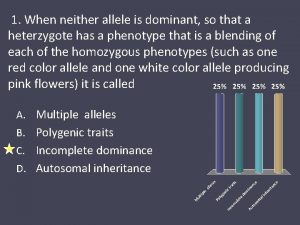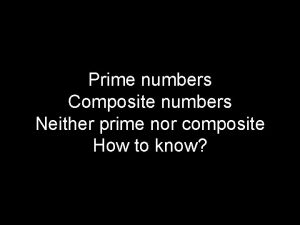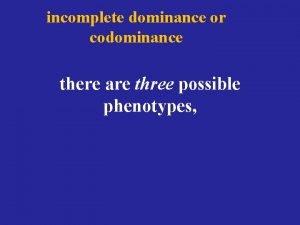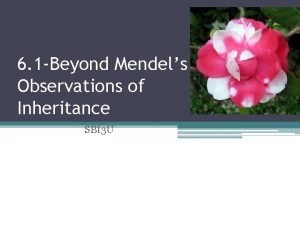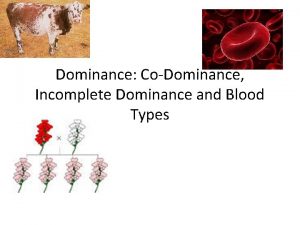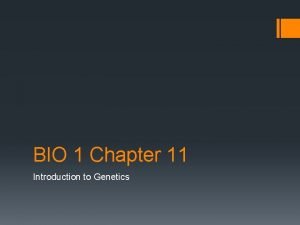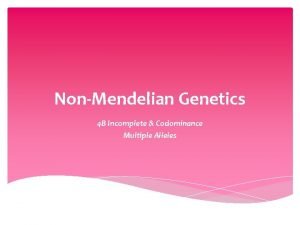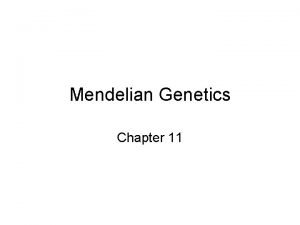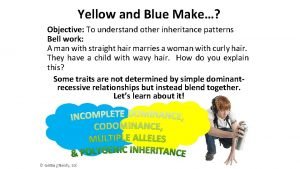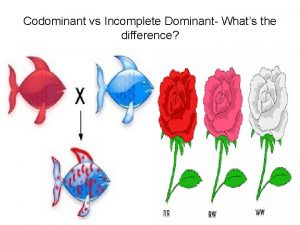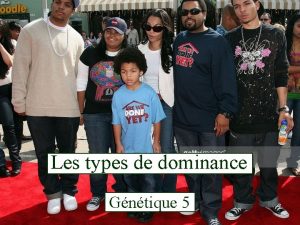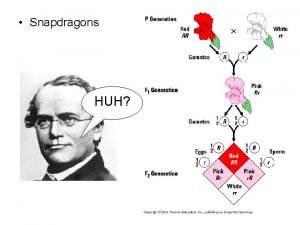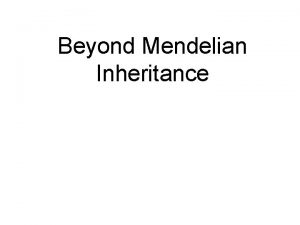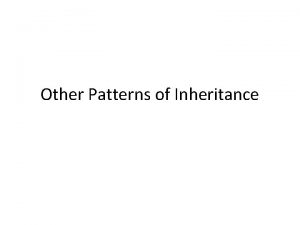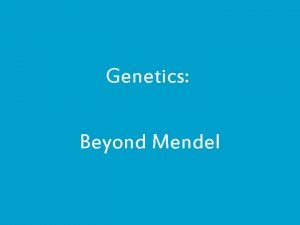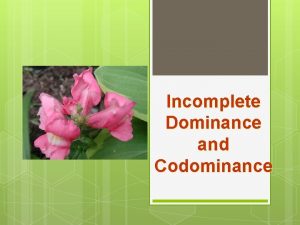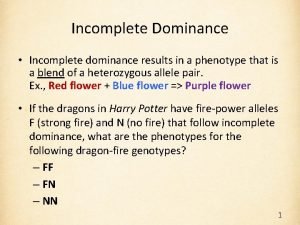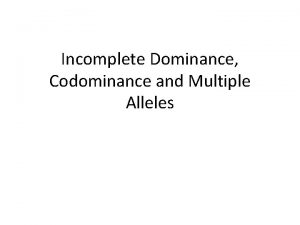Incomplete dominance Incomplete dominance Occurs when neither allele



















- Slides: 19

Incomplete dominance

Incomplete dominance Occurs when neither allele ‘dominates’ the other.

Incomplete dominance Occurs when neither allele ‘dominates’ the other. When both alleles are present in the heterozygous genotype, they both contribute to produce a phenotype that is a blend of the genetic information.

Incomplete dominance Occurs when neither allele ‘dominates’ the other. When both alleles are present in the heterozygous genotype, they both contribute to produce a phenotype that is a blend of the genetic information. Therefore, three different phenotypes may occur.

Incomplete dominance Occurs when neither allele ‘dominates’ the other. When both alleles are present in the heterozygous genotype, they both contribute to produce a phenotype that is a blend of the genetic information. Therefore, three different phenotypes may occur. EG – pure-breeding red (RR) x pure-breeding white (rr) produces all pink (Rr) offspring (such as snapdragons).

Incomplete dominance Occurs when neither allele ‘dominates’ the other. When both alleles are present in the heterozygous genotype, they both contribute to produce a phenotype that is a blend of the genetic information. Therefore, three different phenotypes may occur. EG – pure-breeding red (RR) x pure-breeding white (rr) produces all pink (Rr) offspring (such as snapdragons). EG – Rr crossed to produce (see board for punnett)

Incomplete dominance Occurs when neither allele ‘dominates’ the other. When both alleles are present in the heterozygous genotype, they both contribute to produce a phenotype that is a blend of the genetic information. Therefore, three different phenotypes may occur. EG – pure-breeding red (RR) x pure-breeding white (rr) produces all pink (Rr) offspring (such as snapdragons). EG – Rr crossed to produce (see board for punnett) 1 Red, 2 pink, 1 white

Co-dominance Occurs when both alleles are equally dominant – when both alleles are present in the heterozygous genotype they are both expressed in the phenotype.

Co-dominance Occurs when both alleles are equally dominant – when both alleles are present in the heterozygous genotype they are both expressed in the phenotype. 3 phenotypes can occur EG – Both alleles give capital letters. R for red and W for white for coat colour.

Co-dominance Occurs when both alleles are equally dominant – when both alleles are present in the heterozygous genotype they are both expressed in the phenotype. 3 phenotypes can occur EG – Both alleles give capital letters. R for red and W for white for coat colour. EG – pure-breeding red (RR) x pure-breeding white (WW) produces roan offspring in horses (RW)

Multiple alleles Occur with genes that have more than two different alleles, though an individual will have only two of the alleles in its genotype.

Multiple alleles Occur with genes that have more than two different alleles, though an individual will have only two of the alleles in its genotype. Inheritance of human blood groups shows multiple alleles, complete dominance, and co-dominance.

Multiple alleles Occur with genes that have more than two different alleles, though an individual will have only two of the alleles in its genotype. Inheritance of human blood groups shows multiple alleles, complete dominance, and co-dominance. Three different alleles IA IB i exist for what is the ABO blood grouping. IA and IB are co-dominant; both are completely dominant to i.

Multiple alleles Genotype Phenotype (blood group) IAIA A IBIB B IAIB AB IA i A IB i B ii O IAIB genotype gives AB blood because both the co-dominant alleles are expressed in the phenotype.

Multiple alleles Genotype Phenotype (blood group) IAIA A IBIB B IAIB AB IA i A IB i B ii O IAIB genotype gives AB blood because both the co-dominant alleles are expressed in the phenotype. IA i and IB i give A and B blood because both IA and IB are dominant over i

Multiple alleles examples Page 89

Lethal Alleles Occurs when a mutation results in an allele that produces a non-functional version of an essential protein.

Lethal Alleles Occurs when a mutation results in an allele that produces a non-functional version of an essential protein. If it is inherited, the individual will die before or shortly after birth.

Lethal Alleles Occurs when a mutation results in an allele that produces a non-functional version of an essential protein. If it is inherited, the individual will die before or shortly after birth. EG – in fruit flies. A mutated allele caused ‘curly’ wings rather than normal wings. The mutated allele is dominant. Flies with homozygous genotype for curly wings do not hatch from their eggs. Punnett from pg 90
 Codominance alleles
Codominance alleles Incomplete dominance occurs when
Incomplete dominance occurs when Genotype for straight hair
Genotype for straight hair Incomplete dominance
Incomplete dominance A number which is neither prime nor composite
A number which is neither prime nor composite Example of complete dominance
Example of complete dominance Incomplete dominance
Incomplete dominance Incomplete dominance traits in humans
Incomplete dominance traits in humans Is sickle cell anemia codominant
Is sickle cell anemia codominant Incomplete dominance in snapdragons
Incomplete dominance in snapdragons Incomplete dominance punnett square
Incomplete dominance punnett square The punnett square in figure 11-2
The punnett square in figure 11-2 Codominance incomplete dominance
Codominance incomplete dominance Incomplete dominance definition
Incomplete dominance definition Incomplete dominance definition
Incomplete dominance definition Suit separate
Suit separate Getting nerdy llc genetics you're such a square answer key
Getting nerdy llc genetics you're such a square answer key Whats incomplete dominance
Whats incomplete dominance Incomplete dominance punnett square
Incomplete dominance punnett square Incomplete dominance definition
Incomplete dominance definition


